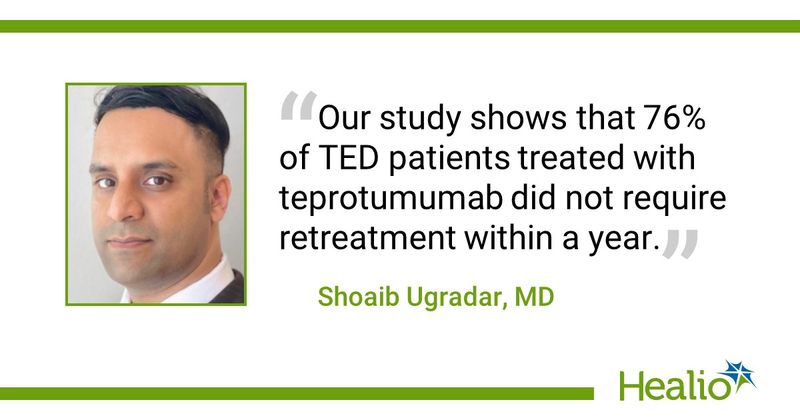Tepezza linked with promising re-treatment rates for thyroid eye disease
Key takeaways:
- Tepezza demonstrated promising re-treatment rates in patients with thyroid eye disease.
- Age may be a significant factor in the need for re-treatment.
Less than 25% of patients with thyroid eye disease who underwent a full course of treatment with Tepezza required re-treatment, according to a study published in Ophthalmology.
“It is becoming increasingly apparent that the [insulin-like growth factor-1 receptor] plays a key role in manifestation of the clinical signs and symptoms of [thyroid eye disease] TED,” Shoaib Ugradar, MD, of TORC-Research and lead author of the study, told Healio. “Teprotumumab addresses the unmet need for an effective medicine for TED that not only may serve as a long-term solution for most patients, but also treats TED at the source – not just the symptoms.”

The multicenter retrospective study included 119 patients with TED from three centers in the U.S. who were given a full course of treatment with Tepezza (teprotumumab-trbw, Amgen), which included infusions of teprotumumab 10 mg/kg for the first infusion and 20 mg/kg for subsequent infusions given, every 3 weeks for 24 weeks. All patients underwent at least 1 year of follow-up after final infusion.
Ugradar and colleagues reviewed the clinical activity score, Gorman diplopia score and the presence of proptosis for each patient at baseline, at the end of the first course and at baseline for the second course, for those who required it, to investigate the rate and drivers of re-treatment.
Overall, 24.4% of patients required re-treatment. In their univariate analysis, researchers found no significant difference in proptosis, diplopia score or duration of TED at baseline for re-treated vs. non-re-treated patients.
Of patients who required re-treatment, 82% had a clinically significant proptosis response (defined as a 2 mm reduction from baseline or more) after their initial treatment course, compared with 68% of patients who did not require re-treatment.
Investigators found re-treated patients were older than patients who did not need re-treatment, as mean age of patients in the re-treated group was 60 years vs. 53 years old for the non-re-treatment group (P < .05). “Our study suggests that age may be a driver behind that need for further treatment,” Ugradar said.
Evidence that TED is a chronic disease suggests that a subset of patients may require further treatment, the authors wrote.
“Our study shows that 76% of TED patients treated with teprotumumab did not require re-treatment within a year,” Ugradar told Healio. “Continued long-term research could help us better understand which patients may need re-treatment with teprotumumab.”
